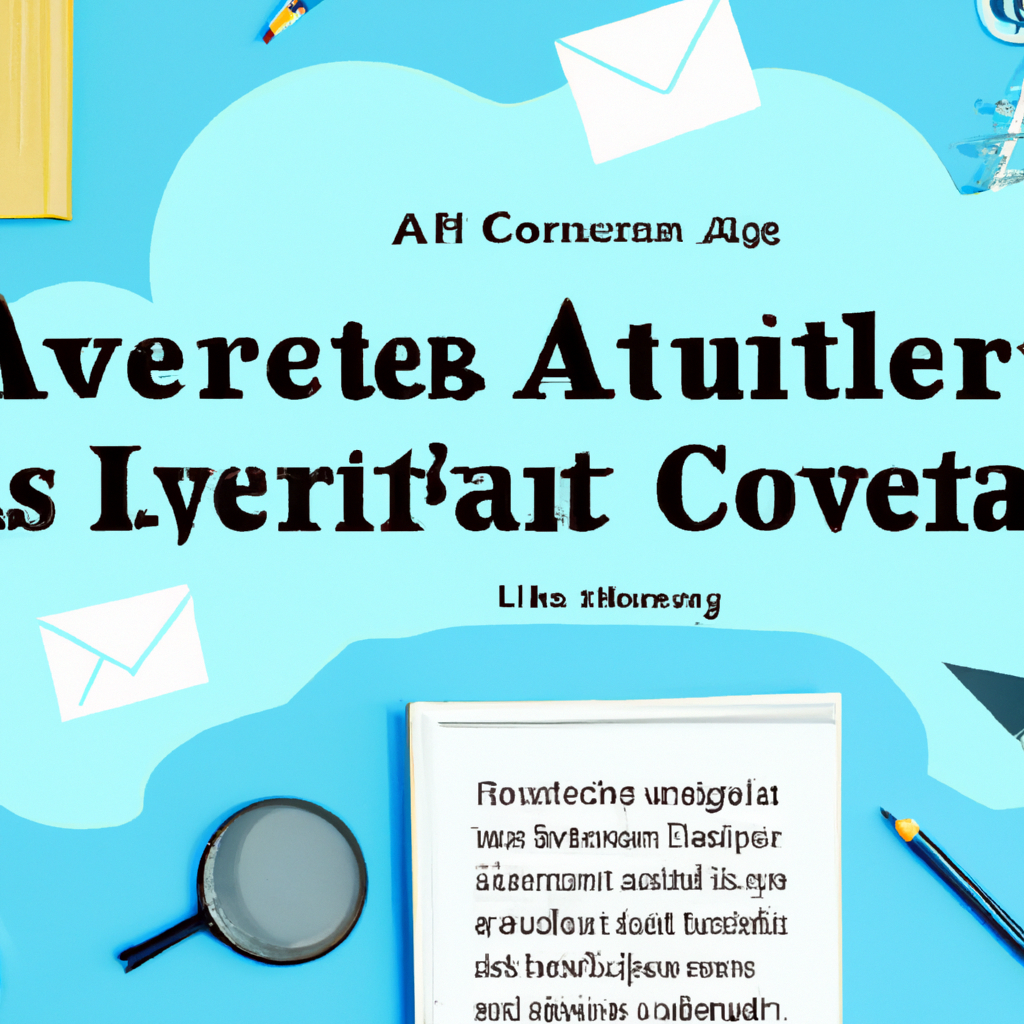In the competitive job market, a well-crafted cover letter can often be the key to securing an interview. But what exactly does a successful cover letter look like? It’s a question that many job seekers grapple with, as they aim to strike the perfect balance between showcasing their skills and qualifications while also demonstrating their enthusiasm and personality. In this article, we will explore the key elements that make up a winning cover letter and provide you with valuable tips to ensure yours stands out from the crowd.

Heading 1: Format and Structure
Subheading 1.1: Contact Information
When crafting a cover letter, it’s essential to include your contact information at the top of the page. This information should be easily visible and should include your full name, phone number, email address, and mailing address. Providing your contact information ensures that the hiring manager can easily reach out to you if they are interested in your application.
Subheading 1.2: Salutation
The salutation is the greeting at the beginning of your cover letter, and it’s important to get it right. If possible, address the hiring manager by name to add a personalized touch. If the job posting does not provide a name, you can use a generic salutation such as “Dear Hiring Manager.” However, it’s always best to try and find the name of the person responsible for hiring to show that you have done your research.
Subheading 1.3: Introduction
The introduction is the first paragraph of your cover letter and serves to capture the attention of the hiring manager. Start by stating the position you’re applying for and how you found out about the job opening. If you have a mutual connection or were referred to the company by someone, this is a great place to mention it. Finally, briefly explain why you are interested in the role and why you believe you are a good fit.
Subheading 1.4: Body Paragraphs
The body paragraphs of your cover letter are where you will showcase your skills, experiences, and qualifications that make you a strong candidate for the position. Each paragraph should focus on a specific skill or experience and provide examples of how you have demonstrated that skill in the past. Use bullet points or numbered lists to make it easy for the hiring manager to scan through your qualifications.
Subheading 1.5: Closing
The closing paragraph is your opportunity to wrap up your cover letter and leave a strong final impression. Express your enthusiasm for the opportunity to join the company and reiterate your interest in the position. Thank the hiring manager for considering your application and express your willingness to provide any additional information or references they may need. Sign off with a professional closing, such as “Sincerely” or “Best regards.”
Subheading 1.6: Signature
At the end of your cover letter, include your full name and your typed signature. This adds a personal touch to your application and shows that you have taken the time to sign the document. If you are submitting a digital copy of your cover letter, you can simply type your name in a professional font. If you are printing and mailing a physical copy, leave space for your handwritten signature.
Heading 2: Tailoring the Content
Subheading 2.1: Research the Company/Organization
Before writing your cover letter, take the time to research the company or organization you are applying to. Look for information about their mission, values, and any recent achievements or projects. This will help you understand the company’s culture and tailor your cover letter to align with their goals and values.
Subheading 2.2: Highlight Relevant Skills and Experiences
When writing your cover letter, it’s important to focus on the skills and experiences that are most relevant to the job you’re applying for. Read through the job description carefully and identify the key qualifications and requirements. Then, highlight your own experiences and skills that directly align with those requirements. This will show the hiring manager that you have the specific abilities they are looking for.
Subheading 2.3: Showcase Achievements
In addition to highlighting your skills and experiences, it’s important to showcase your achievements in your cover letter. Think about any significant accomplishments or projects that you have successfully completed in previous positions. Explain how these achievements demonstrate your abilities and add value to the company. This will help you stand out from other applicants and show that you have a track record of success.
Subheading 2.4: Connect Key Qualifications to Job Requirements
When discussing your skills and experiences in your cover letter, make sure to explicitly connect them to the job requirements. Use specific examples to show how your abilities directly meet the needs of the company. This not only demonstrates your qualifications but also shows that you have taken the time to understand the role and its responsibilities.
Heading 3: Tone and Language
Subheading 3.1: Professional and Polite Tone
When writing your cover letter, it’s important to maintain a professional and polite tone throughout. Avoid using slang or informal language and instead use clear and concise sentences. Use a friendly but respectful tone to show your professionalism and make a positive impression on the hiring manager.
Subheading 3.2: Avoiding Generic Language
To make your cover letter stand out, it’s important to avoid using generic language or cliches. Instead, strive to use specific and descriptive words that highlight your unique qualifications. Avoid copying and pasting phrases from templates or generic cover letters. Instead, make each sentence as specific and personalized as possible.
Subheading 3.3: Keeping it Concise and Coherent
While it’s important to provide enough information in your cover letter, it’s also important to keep it concise and coherent. Avoid rambling or including unnecessary details. Make sure each sentence adds value and contributes to your overall message. Use clear and straightforward language to ensure that your cover letter is easy to read and understand.

Heading 4: Personalization
Subheading 4.1: Addressing the Hiring Manager by Name
To add a personal touch to your cover letter, try to address the hiring manager by name. If the job posting does not provide the name of the hiring manager, do some research to find it. Look on the company’s website, LinkedIn, or other professional networks to find the name of the person responsible for hiring. Addressing the hiring manager by name shows that you have taken the time to research and personalize your application.
Subheading 4.2: Making Genuine Connections
In addition to addressing the hiring manager by name, try to make genuine connections in your cover letter. This could involve mentioning specific projects or initiatives the company is involved in that align with your interests or values. Show that you have done your homework and have a genuine interest in the company and position.
Subheading 4.3: Researching the Hiring Manager if Possible
If you have the opportunity, research the hiring manager to gain a better understanding of their background and interests. Look for commonalities or shared experiences that you can mention in your cover letter. This will help you establish a connection with the hiring manager and make your application more memorable.
Heading 5: Attention to Detail and Proofreading
Subheading 5.1: Correct Grammar, Spelling, and Punctuation
One of the most important aspects of a successful cover letter is attention to detail. Ensure that you use correct grammar, spelling, and punctuation throughout your letter. Proofread your cover letter multiple times to catch any errors or typos. It’s also helpful to have someone else review your letter for additional feedback and to catch any mistakes you may have missed.
Subheading 5.2: Focusing on the Job Description
To make sure your cover letter aligns with the job requirements, pay close attention to the job description. Use the same terminology and keywords used in the description to demonstrate your understanding of the role. This will show the hiring manager that you have thoroughly read and considered the job requirements.
Subheading 5.3: Customizing Each Cover Letter
Avoid the temptation to use a generic cover letter for multiple job applications. Instead, take the time to customize each cover letter to the specific job and company you’re applying to. This includes tailoring your qualifications, experiences, and skills to match the requirements of the position. Customizing your cover letter shows your dedication and interest in the specific job opportunity.
Heading 6: Positive and Enthusiastic Tone
Subheading 6.1: Expressing Excitement for the Opportunity
In order to make a positive impression in your cover letter, it’s important to express your excitement and enthusiasm for the opportunity. Use positive and confident language throughout your letter to show your genuine interest in the position. Let your passion for the job shine through your words.
Subheading 6.2: Emphasizing Motivation and Passion
In addition to expressing excitement, emphasize your motivation and passion for the field or industry. Explain why you are drawn to the specific role and how it aligns with your long-term career goals. By showing your dedication and enthusiasm, you will make a strong case for why you are the ideal candidate for the position.
Heading 7: Including Relevant Keywords
Subheading 7.1: Identifying Keywords in the Job Description
To make your cover letter stand out to hiring managers and applicant tracking systems, identify relevant keywords in the job description. These keywords are often specific skills, experiences, or qualifications that the employer is looking for. By incorporating these keywords into your cover letter, you increase your chances of getting noticed by recruiters.
Subheading 7.2: Incorporating Keywords into the Cover Letter
Once you have identified the relevant keywords, strategically incorporate them into your cover letter. This can be done by using them in your skill descriptions and when discussing your experiences. By using the same language as the job description, you demonstrate that you have the desired qualifications and can speak the same professional language as the company.
Heading 8: Professional Formatting
Subheading 8.1: Using a Clean and Consistent Font
When formatting your cover letter, it’s important to use a clean and consistent font. Choose a professional font that is easy to read, such as Arial or Times New Roman. Use a font size of 11 or 12 to ensure that your cover letter is legible. Additionally, use a simple and professional layout that is easy to navigate.
Subheading 8.2: Organizing the Content with Paragraphs
To ensure that your cover letter is easy to read and understand, organize the content into paragraphs. Use paragraphs to separate different ideas and to create a logical flow in your cover letter. This makes it easier for the hiring manager to scan through your qualifications and achievements.
Subheading 8.3: Utilizing Bullet Points or Numbered Lists for Clarity
When discussing your skills or qualifications, consider using bullet points or numbered lists. This adds clarity to your cover letter and makes it easier for the hiring manager to quickly see your relevant qualifications. Use short and concise bullet points that highlight your key achievements or experiences.
Heading 9: Showcasing Personality and Unique Qualities
Subheading 9.1: Adding a Personal Touch
To make your cover letter more memorable, try adding a personal touch. This could include sharing a brief anecdote or personal story that demonstrates your character or work ethic. Be careful not to overshare or veer too far off-topic, but instead, use the personal touch to show your unique qualities and make a connection with the hiring manager.
Subheading 9.2: Highlighting Transferable Skills and Individual Traits
In addition to showcasing your qualifications and experiences, highlight any transferable skills or individual traits that make you stand out. This could include things like problem-solving abilities, leadership skills, or the ability to work well in a team. By emphasizing these unique qualities, you show the hiring manager that you bring more than just technical qualifications to the role.
Heading 10: Following Instructions and Guidelines
Subheading 10.1: Adhering to the Requested Length
When it comes to cover letters, it’s important to adhere to the requested length outlined in the job posting. If a specific word count or page limit is mentioned, make sure your cover letter fits within those guidelines. If no length is specified, aim to keep your cover letter concise, typically around three to four paragraphs.
Subheading 10.2: Submitting the Cover Letter in the Right Format
When submitting your cover letter, follow any instructions provided by the employer regarding the format. This may include attaching the cover letter as a PDF or Word document or pasting it directly into an online application form. Following the correct format ensures that your cover letter is easily accessible and readable.
Subheading 10.3: Following Application Submission Guidelines
In addition to following specific formatting instructions, make sure to adhere to any other application submission guidelines. This may include submitting the cover letter and resume through a specific portal or including certain documents or information. Failure to follow the submission guidelines can result in your application being overlooked, so pay close attention to these details.



